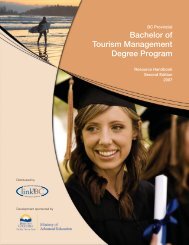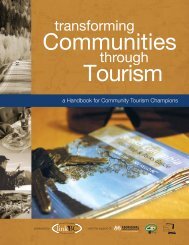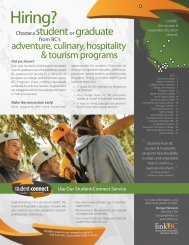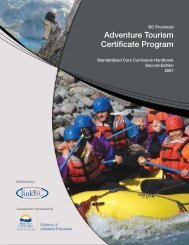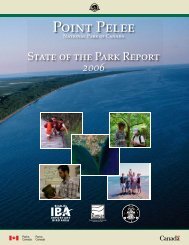Cultural Heritage Tourism Handbook - LinkBC
Cultural Heritage Tourism Handbook - LinkBC
Cultural Heritage Tourism Handbook - LinkBC
- No tags were found...
Create successful ePaper yourself
Turn your PDF publications into a flip-book with our unique Google optimized e-Paper software.
6. Prepare Your People4. Do you have any local “star” attractions that fit the cultural/heritagemould?For instance, does your town have: a popular restaurant that serves unique local food, a quilting orcraftshop, authentic Aboriginal arts and crafts, an antique district, or art galleries and studios? Dothey have the capacity to work together and adopt a “cooperate internally, compete externally”mentality?Do we needmore information?YesNoThe previous chapters of this handbook haveprovided knowledge about cultural/heritagetourism and introduced some key planning considerations.Now, using the “preparing people,places and activities” framework, we’ll look moreclosely at developing cultural and heritage-basedtourism experiences.5. How healthy is your “people infrastructure”?Preparing your people involves a number of steps, including:ensuring effective engagement of task force members, encouragingresidents to act as welcoming hosts, and providing services andexperiences to visitors.How involved are elected officials in non-profit organizations, and in public dialogue about therole of tourism? What is the willingness of the local media, especially the newspaper and localwebsites, to advocate for improved cultural/heritage products and tourism services? Are peoplecurrently working in tourism adequately trained? Is there willingness among shopkeepers, gasstation attendants, and service personnel to embrace the town’s history, make recommendations,and give directions? Are there effective partnerships with local Aboriginal communities?Do we needmore information?YesNo6.1 Welcome Your VisitorsProviding easily accessible visitor services and ensuring guests receivea warm welcome are essential parts of the tourism infrastructure. Theright welcome can have a significant influence on how long visitorsstay, how much they might spend while in the area, and how they’lldescribe their experience to others (i.e., potential future visitors).6. Are “quality-of-life” amenities in our community supported & well-funded?Consider your parks and recreation amenities, libraries, street maintenance, downtown redevelopment,beautification of streetscapes. Evaluate both your community’s financial ability to help developnew assets, and its willingness to invest in these amenities for residents. Are there funding sources(e.g. hotel taxes) that could be tapped to promote cultural/heritage tourism?Do we needmore information?YesNo6.2 Become Good Hosts<strong>Cultural</strong>/heritage tourism destinations need to constantly assess the• Make a good first impression.• Know their job.• Recognize the importance of visitors to the business anddestination.• Know their community.• Understand tourism basics.• Communicate clearly.• Handle problems effectively.• Make a good last impression.level of hospitality visitors receive. While it’s important to improveWith these checklists inhand, you should have a clearunderstanding of your community’sinventory of assets,attitudes, willingness, andcapacity for change. If cultural/heritage tourism still seems arealistic and desirable fit foryour community, you’re readyto lay the groundwork.The first step is to prepare yourpeople.levels of customer service provided by tourism industry professionals,don’t forget that the way visitors see your community is stronglyshaped by interactions they have with residents. Not everyone is atourism booster, but if your community develops cultural/heritagetourism in a way that enhances quality-of-life for all, you can influencecitizens, over time, to be welcoming hosts.Task the businesses and cultural/heritage tourism organizationsin your strategy with determining the most appropriate customerservice training for the community. All front-line employees shouldbe given incentives to attend. Service Best®, FirstHost®, WorldHost®,Client Plus—these short workshops ensure volunteers and front-linestaff understand the importance of good service, and provide practicalskills to create good visitor experiences. These programs vary,but all make sure that those in contact with out-of-town visitors 38 :In addition to preparing front-line staff, progressive tourism organizationswill often develop a tourism awareness campaign for residents.This includes print and online tools outlining “What <strong>Tourism</strong> Means forOur Community,” asking businesses to offer locals free or discountedadmission to attractions. Sometimes this is as simple as encouragingoperators to reach out into the community.Our next case study offers an example of two individuals who do justthat – serving as welcoming hosts to visitors and local ambassadorsfor cultural/heritage tourism in their rural area.4041



